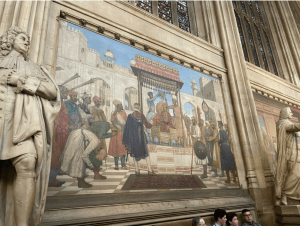As part of my Civilization of India class, we recently had a chance to visit the UK Parliament building, a place filled with history, colonial legacies, and political transformation. Along the walls of the main corridor called St. Stephens hall, there are eight canvases commissioned in 1927 by Lord Peel, Lord Crawford (Chairman of the Fine Arts Commission) and the J. H. Whitley (Speaker of the House of Commons). Sir Henry Newbolt decided the paintings were to depict “The Building of Britain.” Each painting represents one of the eight total centuries from King Alred to Queen Anne. I found this particular piece called “Sir Thomas Roe at the Court of Ajmir” relevant to our studies of India. It takes place in 1614; Sir Thomas Roe was an ambassador of King James I and is pictured here showing his credentials to Emperor Jegangir, aiming to establish a commercial treaty between England and the Moghul Empire. I find the wording rather interesting below the painting: “[he] succeeds by his courtesy and firmness at the Court of Ajmir in laying the foundation of British influence in India.” As the first official ambassador to India, I would hope Sir Thomas Roe was always courteous, yet the usage of the specific word “firmness” makes me question if there was possible coercion involved in his proceedings. This might never be proven or disproven, yet it is confirmed that in his four years of duty (1614-18), he furthered the fortunes of the Enginlish East India Company, likely through unfair exploitation of resources.
From a political standpoint, Dadabhai Naoroji is an important figure in history that progressed India’s path to recognition and respect by Britain. He was the first Asian to sit in the house and stood for progressive political ideals that were unpopular at the time. He advocated for women’s suffrage and access to education, anti-imperialism, self-rule for India, and many more causes that furthered equality of individuals and of the Indian nation. Naoroji’s outspokenness and dedication to his morals makes him a key figure and inspiration for Indians. Yet by his death in 1917, there was still much room for improvement.
Fast forward to the present, and the British-India relationship has vastly progressed. Though the lingering sentiment of colonialism hasn’t fully disappeared in either country, we now see people of Indian origin such as Rishi Sunak, holding significant roles in British politics. Sunak’s appointment as the first Indian Prime Minister in 2020 is a remarkable success story and is a testament to the improvement of leadership opportunities for Indians within England since colonial times. However, are such opportunities limited to high class, educated foreign immigrants? According to a Washington Post article, migrant-receiving countries often “legally discriminate by class based on income, assets, education and skill level.” Furthermore, countries that send migrants abroad discriminate by class, too. This is a system not based on fairness, intelligence, or personal qualities; it’s based on inherent ideas of wealth-based selectivity. Of course, Sunak’s success still defied historical norms and is quite impressive; many Indians “celebrated his ethnic identity for bringing Indians their ‘Obama moment,’ overturning Britain’s racist colonial history.” But we must keep in mind that true equality is not yet achieved.
Overall, our class visit to Parliament offered a fascinating insight into the historical complexities and political transformations surrounding the relationship between Britain and India.


